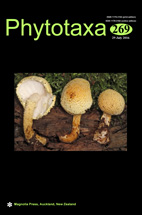Abstract
Diaporthe species are common pathogens, endophytes, or saprobes on a wide range of hosts. During our investigation of forest pathogens, we made collections of Diaporthe species associated with canker and dieback disease of Betula platyphylla and B. albosinensis in Sichuan and Shaanxi provinces in China. Diaporthe betulae sp. nov. and D. betulicola sp. nov. are introduced in this paper, with illustrations, descriptions and support from analysis of ribosomal DNA internal transcribed spacer (ITS), calmodulin (CAL), histone H3 (HIS), translation elongation factor 1-α (TEF1-α) and beta-tubulin (TUB2) sequence data. Diaporthe betulae is characterized by hyaline, ellipsoidal, aseptate, biguttulate, 8.5–11 × 3–4 µm alpha conidia. Diaporthe betulicola is characterized by pycnidial stromata with a single locule with one ostiole per disc. Alpha conidia are hyaline, oblong, aseptate, lack guttules and 9.9–14.7 × 1.3–2.5 µm, and beta conidia are hyaline, spindle-shaped, curved, aseptate and 17–24 × 0.7–1.2 µm.

